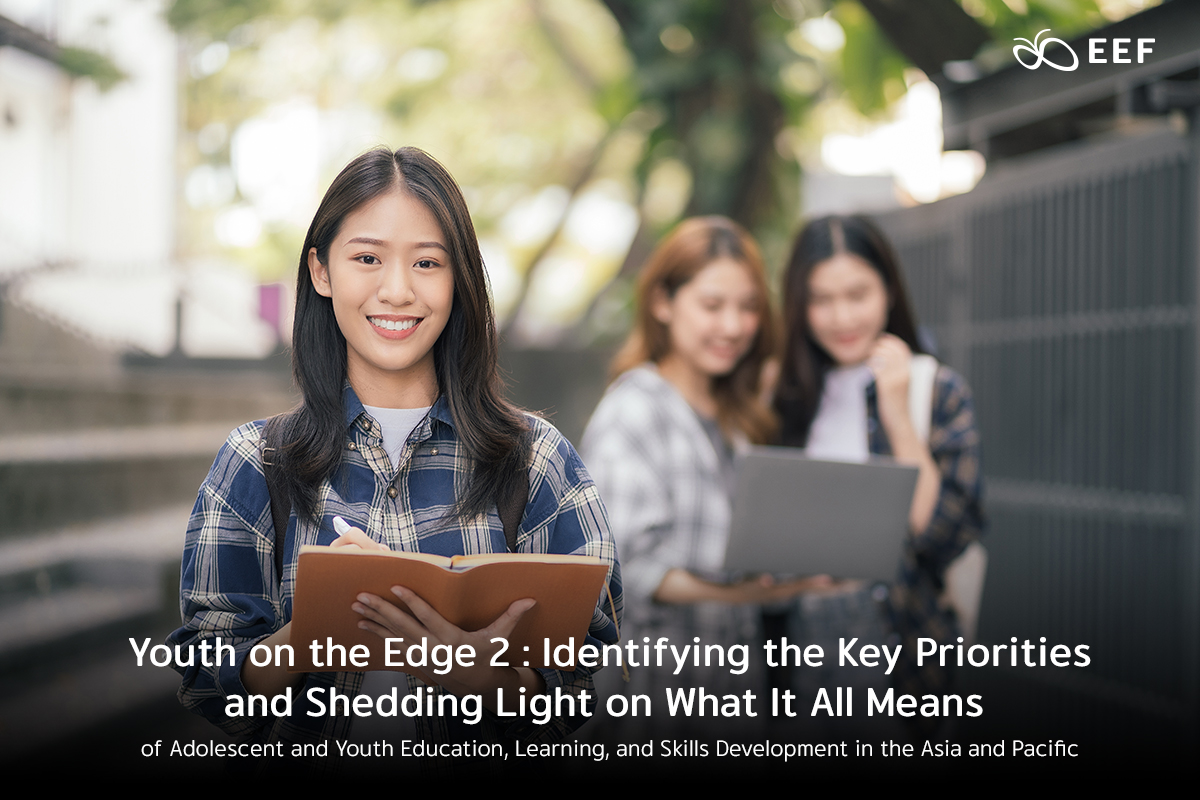
The Asia and Pacific region is teetering on the cusp of a major educational crisis. Access to, retention of, and completion of secondary education remain major challenges, with learning outcomes typically substandard. Without the required competencies and skills, countless adolescents and youth are hindered in their pursuit of higher education and gainful employment. In the worst cases, they are unable to progress at all.
As the nature of work continues to evolve at an increasingly faster pace, the necessity to bridge the gap between traditional education and the modern world of work has never been more pressing — and this is particularly true of the Asia and Pacific region. Technical and Vocational Education and Training (TVET) equips individuals with the qualifications, competencies, and skills they need to thrive in the job market, yet in the region, its utilization and resources remain inadequate, depriving it of reaching its full potential. Meanwhile, alternative learning pathways are available to accommodate individual needs and capacities. Yet, their limited recognition and re-entry points into formal education remain limited, further limiting the potential for transitions into formal education and employment and thus creating yet another additional barrier to success.

And the brewing storm of the looming crisis has been gaining strength by the second. As the pandemic plunged us into uncertainty, it was adolescents and youth that bore the brunt of the catastrophic effects — and this is particularly true of those from socio-economically disadvantaged backgrounds in the Asia and Pacific region. The lockdown further stifled their already insufficient access to quality education and skills training, while the integration between formal and informal education failed to provide the much-needed lifelines for those ending up not in formal education, employment, or training. This has led to a drastic widening of the educational gap, pushing the already fragile state of education to the brink and thereby leaving vulnerable young people on the edge of falling out of education and employment altogether.
With little to no support to acquire the qualifications, competencies, and skills required to progress into higher education and employment, these adolescents and youth are missing out on the opportunity to build a brighter future for themselves and their families. The odds are being overwhelmingly stacked against them every moment that passes, leaving a devastating void so gaping and glaring that it cannot be filled without targeted interventions.

The status quo is grave, to say the least — spiraling quickly out of control, with far-reaching effects that are only worsening. The call for systemic, transformative interventions in the Asia and Pacific region has become increasingly more pressing, as the risk of falling further into crisis is running all-time high. If no steps are taken soon, the consequences will be dire, not only for individuals but also for entire communities across the region. We can no longer wait; It is high time to act now, and we need a sweeping overhaul of Adolescent and Youth Education, Learning, and Skills Development to keep up with the ever-changing world of work. After all, without interventions, every day of learning lost during the crisis can have long-term implications for our adolescent’s and youth’s futures.
In the face of this daunting post-pandemic world, we must rise to the challenges and make addressing learning loss, transforming education and learning for adolescents and youth, and promoting employability skills our top priorities. To effectively ensure that our young people can make up for the losses, we must put in place efficient learning loss recovery strategies, guaranteeing their safe returns to secondary and post-secondary schools and training centers. Furthermore, we must concentrate our efforts on developing quality, relevant, and inclusive secondary education, ensuring that our young people are well-equipped to face the future of work. Additionally, to accommodate the needs of all learners — not just adolescents and youth — we must diversify learning pathways and ensure that everyone has access to a variety of quality formal post-secondary learning pathways, so that they are equipped with the skills for the future of work, thereby embedding a culture of lifelong learning in the society in the process.

Learning Recovery
As the world began to slowly emerge from the unprecedented turmoil brought on by the pandemic, the urgency of re-opening secondary and post-secondary schools and training centers to make up for the lost ground cannot be overstated. Asia-Pacific countries should take necessary measures to ensure successful re-opening and safe return of learners, teachers, and educators, all while safeguarding their safety, health, and well-being at the institutions. As such, comprehensive back-to-school campaigns and targeted re-enrolment measures should be strategically rolled out to identify and re-engage adolescents and youth at risk of not returning to education. Furthermore, upon re-entry, learners’ learning levels should be assessed through diagnostic assessments to effectively identify learning loss gaps and to support learners, catch-up strategies should be tailored to their identified needs to bridge those gaps.
With the unprecedented socio-economic repercussions of the pandemic continuing to be palpably felt throughout the world, Asia-Pacific countries are faced with an urgent obligation to ensure the future of their out-of-school adolescents and youth, who take the heaviest toll of the crisis. To this end, robust investments should be made in alternative education programs to re-engage out-of-school young people, who are at risk of being left behind in learning and bringing them back into the fold. To maximize their effectiveness, multiple pathways should be set up to better meet the individual needs of these learners, considering their educational attainments, ages, and choices, in order to help them learn and develop the qualifications, competencies, and skills necessary for their future success.
Meanwhile, the countries should also recognize and validate the non-formal and informal learning that took place during the pandemic. This alternative mode of learning has enabled many adolescents and youth to remain engaged in their learning and build on their competencies and skills, even amidst school and training center closures and reduced working hours. By offering support and recognition to the learning done through these alternative pathways, these young people can be re-engaged in further learning and re- and up-skilled for further employment, equipped with the competencies and skills necessary for employment prospects. This will ensure that no one is left behind in their pursuit of success.
Transforming Education and Learning for Adolescents and Youth
As the Fourth Industrial Revolution (4IR) continues to unfold and shape the future of the world, Asia-Pacific countries are acutely aware of the need to equip their adolescents and youth with the qualifications, competencies, and skills necessary to thrive in the rapidly changing world. To this end, secondary education reform should be made a focus, with quality, relevance, and inclusivity serving as the core principles of such reform. This entails a comprehensive rethinking of curriculum contents and pedagogical approaches to better integrate 21st-century skills, which include employability skills and socio-emotional skills, making them more learner-centered and collaborative. And this should be coupled with the continuous alignment of instruction time, assessment framework, teacher training, and school quality standards with the intended curriculum and pedagogical intentions.
To ensure that their adolescents and youth are equipped with the competencies and skills they need to succeed in the ever-changing and increasingly complex world, Asia-Pacific countries should explore ways to reduce dropout and promote equity in upper secondary education. One key strategy is none other than delaying the streaming of learners into vocational and general programs until upper secondary, thereby avoiding the use of ability grouping in the process. Moreover, the programs should be designed in a flexible way. This includes allowing learners to transition between programs, or taking a more modular approach, thus providing them with more choices and greater control over their own educational paths. This, in turn, gives them the opportunity to acquire the competencies and skills they need to pursue their dreams.
The unfolding of the 4IR holds tremendous promise for every country. To tap into the opportunities that this revolution brings to the table, Asia-Pacific countries should prioritize the development of quality vocational programs in upper secondary as well as the promotion of their enrolment. As such, investments should be made in developing engaging and relevant curriculum content, training teachers and educators, strengthening the links between educational institutions and the labor markets, and implementing effective communication campaigns, all in an effort to increase the enrolment of adolescents and youth in vocational programs. By taking these steps, the countries can empower their young people to reach their full potential in the 4IR, setting them up for success in their studies and their lives as a whole.
Reaching the end of upper secondary education is a pivotal moment in a learner’s life, one at which their future is determined by the path they choose and the skills they seek to acquire in pursuit of their calling. To enable adolescents and youth to make well-informed decisions, Asia-Pacific countries should rethink their end-of-upper-secondary examination and certification systems, breaking away from traditional paper-based examinations and instead adopting alternative assessment methods, such as student portfolios, project-based assignments, and computer-based assessments. In doing so, this should include certifying all secondary programs, including vocational options, and a broader range of competencies, such as 21st-century skills. This way, adolescents and youth are able to gain a better understanding of the pathways available to them and to make more informed decisions in pursuit of their aspirations.
Promoting Employability Skills
As the world is increasingly shifting towards a green-growth, digitally-driven economy, it is becoming increasingly clear that Asia-Pacific countries should respond with a renewed focus on the development of post-secondary TVET. Investment in quality TVET, with a focus being placed on green and digital skills, should be made to equip their adolescents and youth with the necessary qualifications, competencies, and skills that will enable them to stay ahead of the curve in the new economy. Not only will green and digital skills give them a competitive edge when entering the job market, but a strong foundation of other high-demand skills will help them succeed in their chosen fields. By investing in quality TVET, the countries can ensure that their young people have the proficiency and expertise they need to succeed in the modern economy and seize the new possibilities that come with it.
To ensure the successful, smooth, and lucrative transition of their adolescents and youth to employment, Asia-Pacific countries should focus on the development and maintenance of high-quality labor market information systems. These systems will provide accurate, up-to-date information on labor market needs, enabling the design of relevant training programs to center on the high-growth sectors, as well as competencies and skills that are projected to be in demand. Meanwhile, career and employment guidance should be reinforced and provided throughout their education, to help orient them and give them the best chance of entering the workplace with confidence. By doing so, adolescents and youth in the Asia-Pacific region will be well-equipped to take full advantage of the various opportunities that are available in the labor market.
Now more than ever, it is essential to constantly strive for self-improvement and stay abreast of the ever-evolving world. In order to stay competitive, individuals must commit to a lifetime of learning, continuously updating their knowledge, competencies, and skills in order to remain successful. To truly embrace it, Asia-Pacific countries should make recognition, validation, and accreditation of non-formal and informal learning a top priority. This will be a challenging endeavor though, requiring the development and implementation of coherent guidelines and procedures needed to authenticate competencies and skills acquired through non-formal education programs and informal learning. Nevertheless, to accomplish this grand mission, in addition to these guidelines and regulations on training content to ensure its quality, accreditation and monitoring systems should be put in place. Furthermore, learning pathways should be diversified to meet all learners’ needs, re-engage and keep them engaged in learning, and prepare them for further education and employment. Only through these concerted efforts can the countries ensure that alternative learning pathways are duly recognized and appreciated, thereby truly cultivating a culture of lifelong learning in society.

All in all, it is of utmost importance to bring about a more equitable and holistic Adolescent and Youth Education, Learning, and Skills Development, with wider and more inclusive access to quality education, learning, and skills development. We must ensure that young people are given the right tools and opportunities so that they can thrive in the changing world of work and build better futures for themselves, their communities, and their countries.
Doing so is not only a moral imperative, but rather a socio-economic must, as it will pave the way for a more equitable, resilient, and prosperous future. By taking a comprehensive and systemic approach to Adolescent and Youth Education, Learning, and Skills Development, we can break the cycles of intergenerational poverty, create brighter futures for our adolescents and youth, and by extension, ensure that everyone has access to the resources they need to succeed and reach their full potential. It is time to take action and start investing in our future generations, so that “we” all can reap the benefits and build a better future for us all. This is in line with the Equitable Education Fund (EEF) Thailand’s mission: to address disparities in educational and employment opportunities through research, collaboration, and support for children, youth, and adults in need, thereby fostering a more equitable future for all.
Source:
– POLICY BRIEF: Adolescent and Youth Education, Learning and Skills Development, APREMC 2022
– TECHNICAL PAPER: Adolescent and Youth Education, Learning and Skills Development, APREMC 2022

